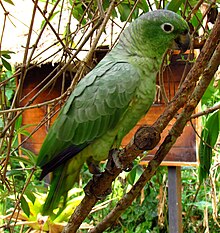
The red-billed blue magpie is a species of bird in the crow family, Corvidae. It is about the same size as the Eurasian magpie, but has a much longer tail, one of the longest of any corvid. It is 65–68 cm (25.5–27 in) long and weighs 196–232 g (6.9–8.2 oz).

The western plantain-eater, also known as the gray plantain-eater or western gray plantain-eater, is a large member of the turaco family, a group of large arboreal near-passerine birds restricted to Africa.
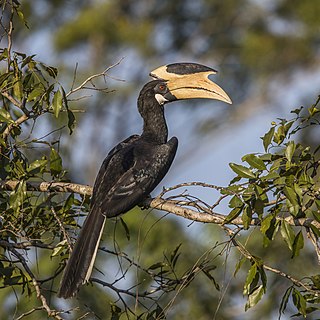
The Malabar pied hornbill, also known as lesser pied hornbill, is a bird in the hornbill family, a family of tropical near-passerine birds found in the Old World.

The white-naped woodpecker is woodpecker which is a widespread but a scarce breeder in the Indian Subcontinent. It is associated with open forest and scrub with some trees. It nests in a tree hole, laying one or two white eggs.
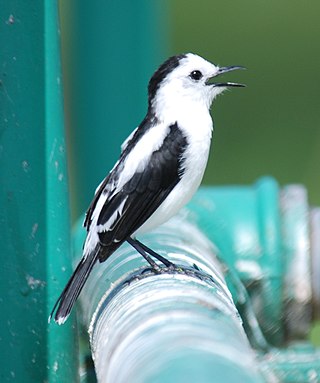
The pied water tyrant is a small passerine bird in the tyrant flycatcher family. It breeds in tropical South America from Panama and Trinidad south to Bolivia.

The southern mealy amazon or southern mealy parrot is among the largest parrots in the genus Amazona, the amazon parrots. It is a mainly green parrot with a total length of 38–41 cm (15–16 in). It is native to tropical Central and South America. This parrot and the northern mealy amazon are considered conspecific.
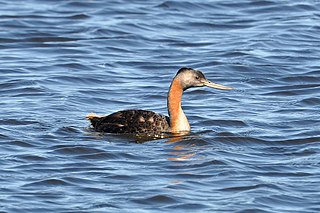
The great grebe is the largest species of grebe in the world. A disjunct population exists in northwestern Peru, while the main distribution is from extreme southeastern Brazil to Patagonia and central Chile. The population from southern Chile is considered a separate subspecies, P. m. navasi.

The great-billed parrot also known as Moluccan parrot or island parrot, is a medium-sized, approximately 38 cm long, green parrot with a massive red bill, cream iris, blackish shoulders, olive green back, pale blue rump and yellowish green underparts. The female is typically smaller than the male, but otherwise the sexes are similar.

The greater striped swallow is a large swallow that is native to Africa south of the equator.

The banded martin or banded sand martin is a small passerine bird in the swallow family Hirundinidae that is endemic to Africa. It is the only species placed in the genus Neophedina.

The Madagascar ibis, also known as the Madagascar crested ibis, white-winged ibis or crested wood ibis, is a medium-sized, brown-plumaged ibis. It has bare red orbital skin, yellow bill, red legs, white wings and its head is partially bare with a dense crest of green or gloss blue and white plumes on the nape. The Madagascar ibis is the only member of the genus Lophotibis.
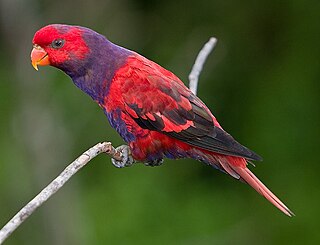
The violet-necked lory is a species of parrot in the family Psittaculidae. It is endemic to Indonesia, where it is found in the northern Maluku Islands and west Papuan islands. Its natural habitats are tropical moist lowland forests and tropical mangrove forests.

The lilac-tailed parrotlet is a species of bird in subfamily Arinae of the family Psittacidae, the African and New World parrots. It is found in Colombia, French Guiana, Guyana, Suriname, Trinidad, and Venezuela.

The variegated antpitta is a species of bird in the family Grallariidae. It is found in southeastern Brazil, eastern Paraguay, the Guianas and the northern Amazon Basin. Its range extends to Venezuela in the northwest; in the Amazon Basin, it is found in the downstream half of the basin, as well as in the Atlantic outlet region of the neighboring Tocantins-Araguaia River drainage to the southeast. A minor disjunct population is in Peru, and an Argentinian population is found in the tongue of land between Paraguay and southern Brazil.
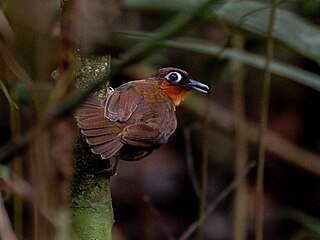
The rufous-throated antbird is a species of bird in subfamily Thamnophilinae of family Thamnophilidae, the "typical antbirds". It is found in Brazil, French Guiana, Guyana, Suriname, and Venezuela.
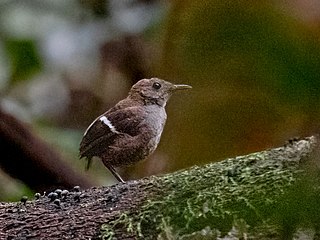
The wing-banded wren is a species of bird in the family Troglodytidae. It is found in Brazil, Ecuador, French Guiana, Guyana, Peru, Suriname, and Venezuela.

The hooded tanager is a species of bird in the tanager family Thraupidae. It is found in Argentina, Bolivia, Brazil, Colombia, French Guiana, Guyana, Paraguay, Peru, and Venezuela. Its natural habitats are subtropical or tropical moist lowland forest, subtropical or tropical mangrove forest, and heavily degraded former forest.
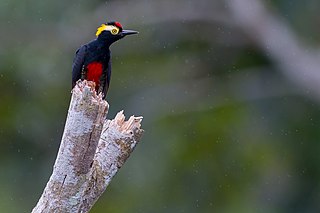
The yellow-tufted woodpecker is a species of woodpecker. It is found in Bolivia, Brazil, Colombia, Ecuador, French Guiana, Guyana, Peru, Suriname, and Venezuela. Its natural habitats are subtropical or tropical moist lowland forests and heavily degraded former forest.

The white-bellied seedsnipe is a species of bird in suborder Scolopaci of order Charadriiformes, the shorebirds. It is found Argentina and Chile.

The Guianan warbling antbird is an insectivorous bird in the antbird family, Thamnophilidae. It is found at lower levels in humid forest in the Guianas, far eastern Venezuela, and north-eastern Brazil.
